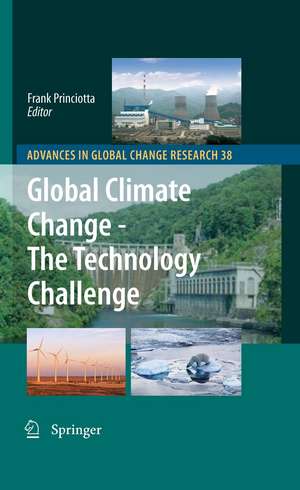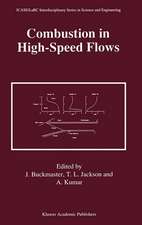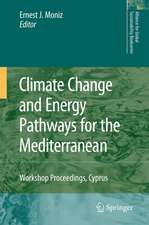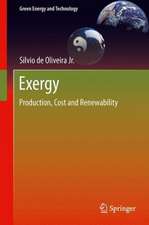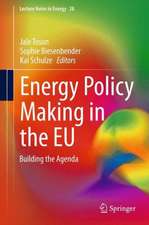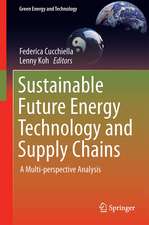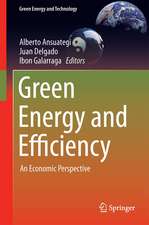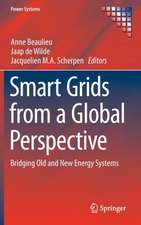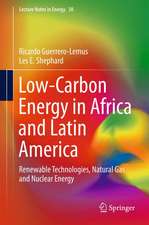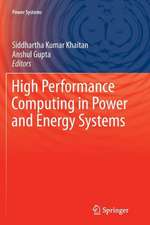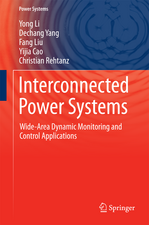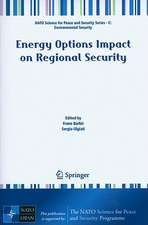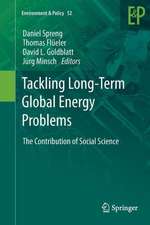Global Climate Change - The Technology Challenge: Advances in Global Change Research, cartea 38
Editat de Frank Princiottaen Limba Engleză Paperback – 15 iul 2013
This book quantifies the mitigation challenge. It then considers the status of key technologies needed to protect the planet from serious climate change impact. Current and emerging technologies are characterized for their mitigation potential, status of development and potential environmental impacts. Power generation, mobile sources, industrial and building sectors are evaluated in detail. The importance and unique challenges for rapidly developing countries, such as China and India are discussed. Current global research and development efforts for key technologies are discussed. It is concluded that it will be necessary to substantially upgrade and accelerate the current worldwide RDD&D effort on both emerging energy technologies and those enabling technologies needed to improve mitigation effectiveness and economics. It will also be necessary to carefully evaluate the potential environmental characteristics of next generation technologies to avoid unacceptable health and ecological impacts.
Finally, given the monumental technological challenge associated with transforming the world’s energy system, geoengineering options are evaluated, since if successfully deployed, they have the potential to allow more time for the necessary energy system transformation.
‘This book on Climate Change not only gives a clear picture of the problem but suggests many of the pitfalls in solving it and recommends strongly, a research programto fill the gaps in our knowledge. It is a most useful reference book for all aspects of the problem.’ William D. Ruckelshaus, Madrona Venture Group/Evergreen Venture
| Toate formatele și edițiile | Preț | Express |
|---|---|---|
| Paperback (1) | 1223.88 lei 6-8 săpt. | |
| SPRINGER NETHERLANDS – 15 iul 2013 | 1223.88 lei 6-8 săpt. | |
| Hardback (1) | 1225.16 lei 6-8 săpt. | |
| SPRINGER NETHERLANDS – 21 mai 2011 | 1225.16 lei 6-8 săpt. |
Din seria Advances in Global Change Research
- 15%
 Preț: 636.12 lei
Preț: 636.12 lei -
 Preț: 439.83 lei
Preț: 439.83 lei - 18%
 Preț: 895.45 lei
Preț: 895.45 lei - 15%
 Preț: 648.24 lei
Preț: 648.24 lei - 18%
 Preț: 1036.54 lei
Preț: 1036.54 lei - 18%
 Preț: 894.16 lei
Preț: 894.16 lei - 18%
 Preț: 963.60 lei
Preț: 963.60 lei - 18%
 Preț: 1239.49 lei
Preț: 1239.49 lei - 15%
 Preț: 649.71 lei
Preț: 649.71 lei - 18%
 Preț: 1243.78 lei
Preț: 1243.78 lei - 18%
 Preț: 1114.02 lei
Preț: 1114.02 lei - 15%
 Preț: 648.89 lei
Preț: 648.89 lei - 18%
 Preț: 960.78 lei
Preț: 960.78 lei - 15%
 Preț: 643.99 lei
Preț: 643.99 lei - 18%
 Preț: 1834.44 lei
Preț: 1834.44 lei - 15%
 Preț: 649.06 lei
Preț: 649.06 lei - 18%
 Preț: 955.70 lei
Preț: 955.70 lei - 18%
 Preț: 956.03 lei
Preț: 956.03 lei - 18%
 Preț: 1232.26 lei
Preț: 1232.26 lei - 18%
 Preț: 955.88 lei
Preț: 955.88 lei - 18%
 Preț: 959.19 lei
Preț: 959.19 lei - 18%
 Preț: 944.82 lei
Preț: 944.82 lei - 18%
 Preț: 1105.19 lei
Preț: 1105.19 lei - 15%
 Preț: 644.49 lei
Preț: 644.49 lei - 15%
 Preț: 643.99 lei
Preț: 643.99 lei - 18%
 Preț: 1841.54 lei
Preț: 1841.54 lei - 18%
 Preț: 1225.94 lei
Preț: 1225.94 lei - 18%
 Preț: 954.62 lei
Preț: 954.62 lei - 5%
 Preț: 1414.80 lei
Preț: 1414.80 lei
Preț: 1223.88 lei
Preț vechi: 1492.53 lei
-18% Nou
Puncte Express: 1836
Preț estimativ în valută:
234.22€ • 254.33$ • 196.74£
234.22€ • 254.33$ • 196.74£
Carte tipărită la comandă
Livrare economică 22 aprilie-06 mai
Preluare comenzi: 021 569.72.76
Specificații
ISBN-13: 9789400736160
ISBN-10: 9400736169
Pagini: 432
Ilustrații: XII, 420 p.
Dimensiuni: 155 x 235 x 23 mm
Greutate: 0.62 kg
Ediția:2011
Editura: SPRINGER NETHERLANDS
Colecția Springer
Seria Advances in Global Change Research
Locul publicării:Dordrecht, Netherlands
ISBN-10: 9400736169
Pagini: 432
Ilustrații: XII, 420 p.
Dimensiuni: 155 x 235 x 23 mm
Greutate: 0.62 kg
Ediția:2011
Editura: SPRINGER NETHERLANDS
Colecția Springer
Seria Advances in Global Change Research
Locul publicării:Dordrecht, Netherlands
Public țintă
ResearchCuprins
Introduction
Chapter 1: Glomate Climate Change and the Mitigation Challenge
Chapter 2: Coal-And Coal/Biomass-Based Power Generation
Chapter 3: Coal and Biomass to Liquid Fuels
Chapter 4: The Role of Nuclear Power in Reducing Greenhouse Gas Emissions
Chapter 5: Renewable Energy: Status and Prospects – Status of Electricity Generation from Renewable Energy
Chapter 6: Mobile Source Mitigation Opportunities
Chapter 7: Buildings: Mitigation Opportunities with a Focus on Health Implications
Chapter 8: Reduction of Multi-Pollutant Emissions from Industrial Sectors: The U.S. Cement Industry – A Case Study
Chapter 9: Geoengineering: Direct Mitigation of Climate Warming
Chapter 10: Research, Development, Demonstration, and Deployment Issues in the Power Sector
Chapter 11: The Role of Technology in Mitigating Greenhouse Gas Emissions from Power Sector in Developing Countries: The case of China, India, and Mexico
Chapter 12: Potential Adverse Environmental Impacts of Greenhouse Gas Mitigation Strategies
Index
Chapter 1: Glomate Climate Change and the Mitigation Challenge
Chapter 2: Coal-And Coal/Biomass-Based Power Generation
Chapter 3: Coal and Biomass to Liquid Fuels
Chapter 4: The Role of Nuclear Power in Reducing Greenhouse Gas Emissions
Chapter 5: Renewable Energy: Status and Prospects – Status of Electricity Generation from Renewable Energy
Chapter 6: Mobile Source Mitigation Opportunities
Chapter 7: Buildings: Mitigation Opportunities with a Focus on Health Implications
Chapter 8: Reduction of Multi-Pollutant Emissions from Industrial Sectors: The U.S. Cement Industry – A Case Study
Chapter 9: Geoengineering: Direct Mitigation of Climate Warming
Chapter 10: Research, Development, Demonstration, and Deployment Issues in the Power Sector
Chapter 11: The Role of Technology in Mitigating Greenhouse Gas Emissions from Power Sector in Developing Countries: The case of China, India, and Mexico
Chapter 12: Potential Adverse Environmental Impacts of Greenhouse Gas Mitigation Strategies
Index
Recenzii
From the reviews:
“This book addresses the challenges associated with mitigation of carbon dioxide emissions from combustion of fossil fuels, and reviews and evaluates the various technologies to reduce emissions and stabilize carbon dioxide concentrations. … There are many good references at the end of most chapters. Summing Up: Recommended. Upper-division undergraduate through professionals; general readers.” (L. E. Erickson, Choice, Vol. 49 (4), December, 2011)
“This book addresses the challenges associated with mitigation of carbon dioxide emissions from combustion of fossil fuels, and reviews and evaluates the various technologies to reduce emissions and stabilize carbon dioxide concentrations. … There are many good references at the end of most chapters. Summing Up: Recommended. Upper-division undergraduate through professionals; general readers.” (L. E. Erickson, Choice, Vol. 49 (4), December, 2011)
Textul de pe ultima copertă
In order to avoid the potentially catastrophic impacts of global warming, the current 3% CO2 global emission growth rate must be transformed to a 1 to 3% declining rate, as soon as possible. This will require a rapid and radical transformation of the world’s energy production and end use systems. The current generation of energy technologies are not capable of achieving the level of mitigation required. Next generations of renewable, low carbon generation and end use technologies will be needed.
This book quantifies the mitigation challenge. It then considers the status of key technologies needed to protect the planet from serious climate change impact. Current and emerging technologies are characterized for their mitigation potential, status of development and potential environmental impacts. Power generation, mobile sources, industrial and building sectors are evaluated in detail. The importance and unique challenges for rapidly developing countries, such as China and India are discussed. Current global research and development efforts for key technologies are discussed. It is concluded that it will be necessary to substantially upgrade and accelerate the current worldwide RDD&D effort on both emerging energy technologies and those enabling technologies needed to improve mitigation effectiveness and economics. It will also be necessary to carefully evaluate the potential environmental characteristics of next generation technologies to avoid unacceptable health and ecological impacts.
Finally, given the monumental technological challenge associated with transforming the world’s energy system, geoengineering options are evaluated, since if successfully deployed, they have the potential to allow more time for the necessary energy system transformation.
‘This book on Climate Change not only gives a clear picture of the problem but suggests many of the pitfalls in solving it and recommends strongly, a research program tofill the gaps in our knowledge. It is a most useful reference book for all aspects of the problem.’ William D. Ruckelshaus, Madrona Venture Group/Evergreen Venture
This book quantifies the mitigation challenge. It then considers the status of key technologies needed to protect the planet from serious climate change impact. Current and emerging technologies are characterized for their mitigation potential, status of development and potential environmental impacts. Power generation, mobile sources, industrial and building sectors are evaluated in detail. The importance and unique challenges for rapidly developing countries, such as China and India are discussed. Current global research and development efforts for key technologies are discussed. It is concluded that it will be necessary to substantially upgrade and accelerate the current worldwide RDD&D effort on both emerging energy technologies and those enabling technologies needed to improve mitigation effectiveness and economics. It will also be necessary to carefully evaluate the potential environmental characteristics of next generation technologies to avoid unacceptable health and ecological impacts.
Finally, given the monumental technological challenge associated with transforming the world’s energy system, geoengineering options are evaluated, since if successfully deployed, they have the potential to allow more time for the necessary energy system transformation.
‘This book on Climate Change not only gives a clear picture of the problem but suggests many of the pitfalls in solving it and recommends strongly, a research program tofill the gaps in our knowledge. It is a most useful reference book for all aspects of the problem.’ William D. Ruckelshaus, Madrona Venture Group/Evergreen Venture
Caracteristici
The book documents that from an energy/climate change viewpoint, civilization is on an unsustainable course The book describes the status of technologies needed to protect the planet for future generations The book concludes current technologies are inadequate and are not being developed at a pace consistent with the need Geoengineering options are objectively considered; although only in conceptual stages, they offer the potential to allow humankind to buy time as we transform our energy production and use system The book analyzes the unique mitigation challenges facing rapidly developing countries, such as China and India Includes supplementary material: sn.pub/extras
